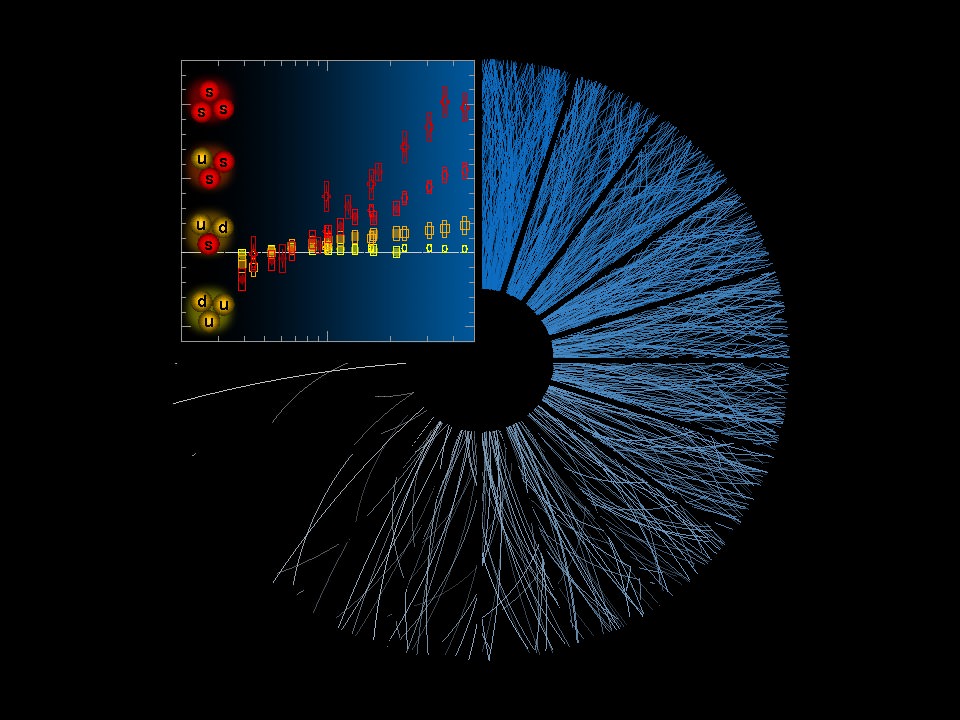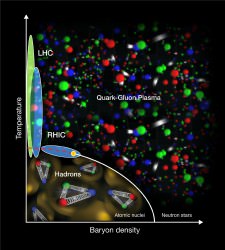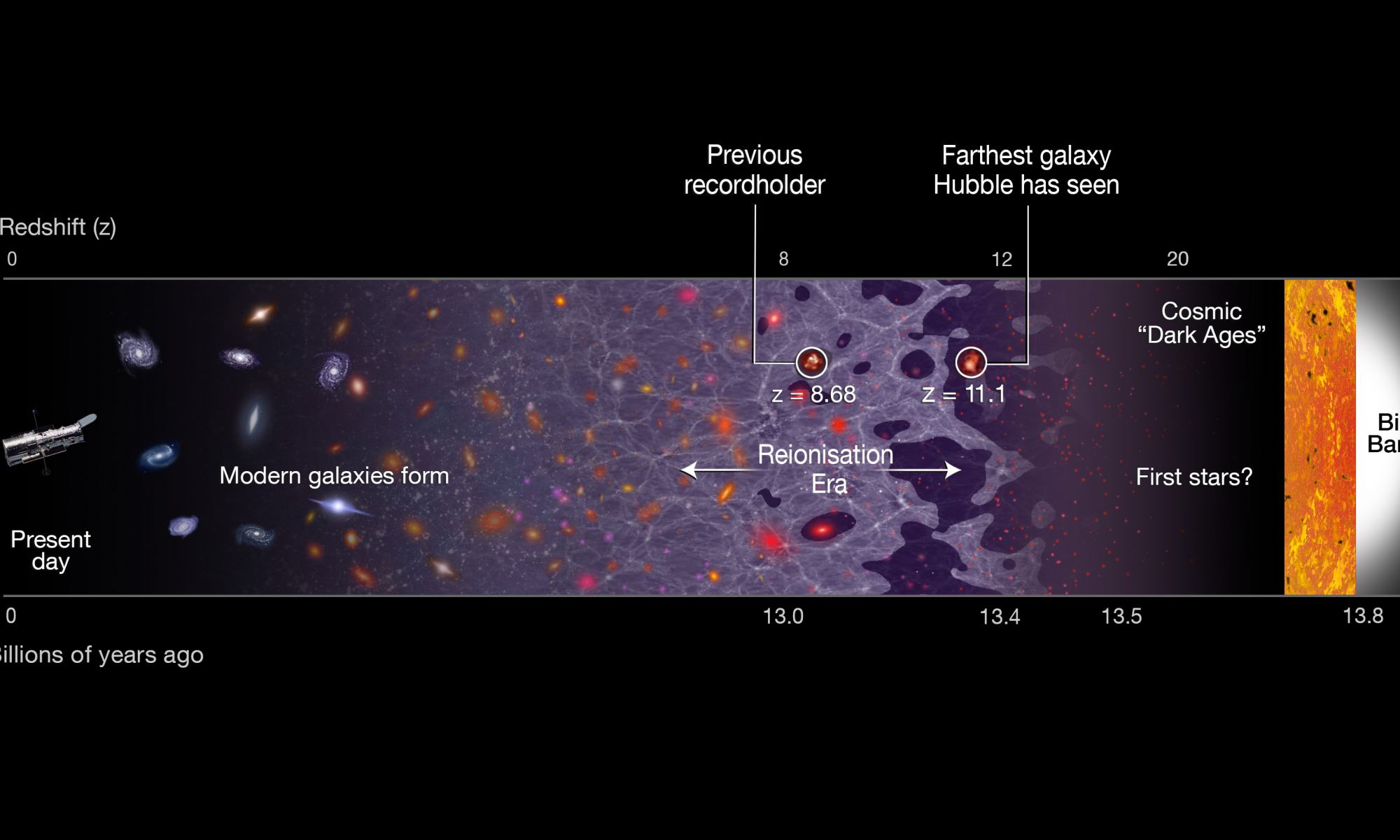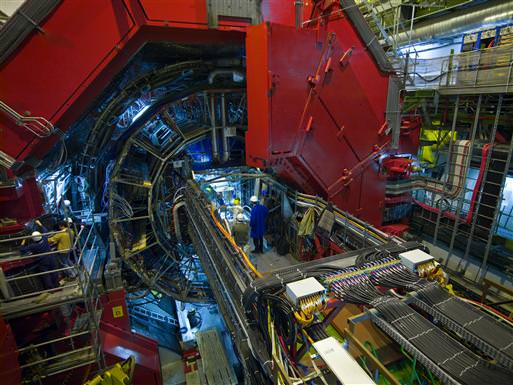It’s often said that in its earliest moments the universe was in a hot, dense state. While that’s a reasonably accurate description, it’s also quite vague. What exactly was it that was hot and dense, and what state was it in? Answering that question takes both complex theoretical modeling and high-energy experiments in particle physics. But as a recent study shows, we are learning quite a bit.
Continue reading “What Happened Moments After the Big Bang?”Neutron Stars Could Have a Layer of Exotic Quark Matter Inside Them
Neutron stars are strange things. They can form when gravity kills a star, crushing its remains into a dense ball the size of a small city. They are so dense that only quantum forces and the Pauli exclusion principle keeps it from collapsing into a black hole singularity. The interior of a neutron star is so dense that matter behaves in ways we still don’t fully understand.
Continue reading “Neutron Stars Could Have a Layer of Exotic Quark Matter Inside Them”Another Strange Discovery From LHC That Nobody Understands

There are some strange results being announced in the physics world lately. A fluid with a negative effective mass, and the discovery of five new particles, are all challenging our understanding of the universe.
New results from ALICE (A Large Ion Collider Experiment) are adding to the strangeness.
ALICE is a detector on the Large Hadron Collider (LHC). It’s one of seven detectors, and ALICE’s role is to “study the physics of strongly interacting matter at extreme energy densities, where a phase of matter called quark-gluon plasma forms,” according to the CERN website. Quark-gluon plasma is a state of matter that existed only a few millionths of a second after the Big Bang.
In what we might call normal matter—that is the familiar atoms that we all learn about in high school—protons and neutrons are made up of quarks. Those quarks are held together by other particles called gluons. (“Glue-ons,” get it?) In a state known as confinement, these quarks and gluons are permanently bound together. In fact, quarks have never been observed in isolation.

The LHC is used to collide particles together at extremely high speeds, creating temperatures that can be 100,000 times hotter than the center of our Sun. In new results just released from CERN, lead ions were collided, and the resulting extreme conditions come close to replicating the state of the Universe those few millionths of a second after the Big Bang.
In those extreme temperatures, the state of confinement was broken, and the quarks and gluons were released, and formed quark-gluon plasma.
So far, this is pretty well understood. But in these new results, something additional happened. There was increased production of what are called “strange hadrons.” Strange hadrons themselves are well-known particles. They have names like Kaon, Lambda, Xi and Omega. They’re called strange hadrons because they each have one “strange quark.”
If all of this seems a little murky, here’s the dinger: Strange hadrons may be well-known particles, because they’ve been observed in collisions between heavy nuclei. But they haven’t been observed in collisions between protons.
“Being able to isolate the quark-gluon-plasma-like phenomena in a smaller and simpler system…opens up an entirely new dimension for the study of the properties of the fundamental state that our universe emerged from.” – Federico Antinori, Spokesperson of the ALICE collaboration.
“We are very excited about this discovery,” said Federico Antinori, Spokesperson of the ALICE collaboration. “We are again learning a lot about this primordial state of matter. Being able to isolate the quark-gluon-plasma-like phenomena in a smaller and simpler system, such as the collision between two protons, opens up an entirely new dimension for the study of the properties of the fundamental state that our universe emerged from.”
Enhanced Strangeness?
The creation of quark-gluon plasma at CERN provides physicists an opportunity to study the strong interaction. The strong interaction is also known as the strong force, one of the four fundamental forces in the Universe, and the one that binds quarks into protons and neutrons. It’s also an opportunity to study something else: the increased production of strange hadrons.
In a delicious turn of phrase, CERN calls this phenomenon “enhanced strangeness production.” (Somebody at CERN has a flair for language.)
Enhanced strangeness production from quark-gluon plasma was predicted in the 1980s, and was observed in the 1990s at CERN’s Super Proton Synchrotron. The ALICE experiment at the LHC is giving physicists their best opportunity yet to study how proton-proton collisions can have enhanced strangeness production in the same way that heavy ion collisions can.
According to the press release announcing these results, “Studying these processes more precisely will be key to better understand the microscopic mechanisms of the quark-gluon plasma and the collective behaviour of particles in small systems.”
I couldn’t have said it better myself.
Physicists Closing in on Understanding the Primordial Universe
Photo of the ALICE detector at CERN. Photo courtesy of CERN.
Slamming barely nothing together is bringing scientists ever-closer to understanding the weird states of matter present just milliseconds after the creation of the Universe in the Big Bang. This is according to physicists from CERN and Brookhaven National Laboratory, presenting their latest findings at the Quark Matter 2012 conference in Washington, DC.
By smashing ions of lead together within CERN’s lesser-known ALICE heavy-ion experiment, physicists said Monday that they created the hottest man-made temperatures ever. In an instant, CERN scientists recreated a quark-gluon plasma — at temperatures 38 percent hotter than a previous record 4-trillion degree plasma. This plasma is a subatomic soup and the very unique state of matter thought to have existed in the earliest moments after the Big Bang. Earlier experiments have shown these particular varieties of plasmas behave like perfect, frictionless liquids. This finding means that physicists are studying the densest and hottest matter ever created in a laboratory; 100,000 times hotter than the interior of our Sun and denser than a neutron star.
CERN’s scientists are just coming off of their July announcement of the discovery of the elusive Higgs boson.
“The field of heavy-ion physics is crucial for probing the properties of matter in the primordial universe, one of the key questions of fundamental physics that the LHC and its experiments are designed to address. It illustrates how in addition to the investigation of the recently discovered Higgs-like boson, physicists at the LHC are studying many other important phenomena in both proton–proton and lead–lead collisions,” said CERN Director-General Rolf Heuer.
According to a press release, the findings help scientists understand the “evolution of high-density, strongly interacting matter in both space and time.”
Meanwhile, scientists at Brookhaven’s Relativistic Heavy Ion Collider (RHIC), say they have observed the first glimpse of a possible boundary separating ordinary matter, composed of protons and neutrons, from the hot primordial plasma of quarks and gluons in the early Universe. Just as water exists in different phases, solid, liquid or vapor, depending on temperature and pressure, RHIC physicists are unraveling the boundary where ordinary matter starts to form from the quark gluon plasma by smashing gold ions together. Scientists are still not sure where to draw the boundary lines, but RHIC is providing the first clues.
The nuclei of today’s ordinary atoms and the primordial quark-gluon plasma, or QGP, represent two different phases of matter and interact at the most basic of Nature’s forces. These interactions are described in a theory known as quantum chromodynamics, or QCD. Findings from RHIC’s STAR and PHENIX show that the perfect liquid properties of the quark gluon plasma dominate at energies above 39 billion electron volts (GeV). As the energy dissipates, interactions between quarks and the protons and neutrons of ordinary matter begin to appear. Measuring these energies give scientists signposts pointing to the approach of a boundary between ordinary matter and the QGP.
 “The critical endpoint, if it exists, occurs at a unique value of temperature and density beyond which QGP and ordinary matter can co-exist,” said Steven Vigdor, Brookhaven’s Associate Laboratory Director for Nuclear and Particle Physics, who leads the RHIC research program. “It is analogous to a critical point beyond which liquid water and water vapor can co-exist in thermal equilibrium, he said.
“The critical endpoint, if it exists, occurs at a unique value of temperature and density beyond which QGP and ordinary matter can co-exist,” said Steven Vigdor, Brookhaven’s Associate Laboratory Director for Nuclear and Particle Physics, who leads the RHIC research program. “It is analogous to a critical point beyond which liquid water and water vapor can co-exist in thermal equilibrium, he said.
While Brookhaven’s particle accelerator cannot match CERN’s record-setting temperature conditions, scientists at the U.S Energy Department lab say the machine maps the “sweet spot” in this phase transition.
Image caption: The nuclear phase diagram: RHIC sits in the energy “sweet spot” for exploring the transition between ordinary matter made of hadrons and the early universe matter known as quark-gluon plasma. Courtesy of the U.S. Department of Energy’s Brookhaven National Laboratory.
John Williams is a science writer and owner of TerraZoom, a Colorado-based web development shop specializing in web mapping and online image zooms. He also writes the award-winning blog, StarryCritters, an interactive site devoted to looking at images from NASA’s Great Observatories and other sources in a different way. A former contributing editor for Final Frontier, his work has appeared in the Planetary Society Blog, Air & Space Smithsonian, Astronomy, Earth, MX Developer’s Journal, The Kansas City Star and many other newspapers and magazines.



